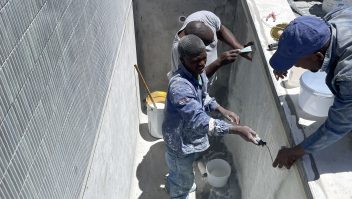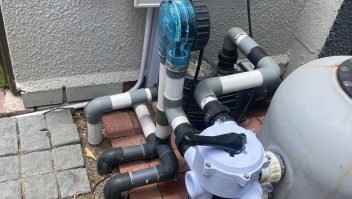When installing a fibreglass pool in South Africa, choosing the right backfill material is crucial for the long-term durability and safety of your pool. Gravel backfill has emerged as the best option for fibreglass pools, outperforming sand and other materials in preventing structural issues like wall bulging and plumbing leaks. In this post, we explain why gravel backfill is essential, especially for South African soil and climate conditions, and how it protects your investment.
What is Backfill and Why Does It Matter?
Backfill refers to the material used to fill the space between the fibreglass pool shell and the surrounding ground after the pool is installed. Proper backfilling supports the pool structure, prevents ground movement, and ensures plumbing stability.
Using the wrong backfill can cause serious problems such as:
- Pool walls bulging or deforming
- Plumbing settling and subsequent leaks
- Pool structural failure over time
Why Gravel Backfill Is Ideal for Fibreglass Pools
1. Stability in High Water Table Areas
Many regions in South Africa, especially coastal areas like Cape Town, Durban, and Port Elizabeth, have high water tables or clayey soil prone to water retention. Unlike sand, gravel does not liquefy when saturated. This means the gravel maintains its shape and firmness, reducing lateral pressure on the pool walls.
2. Excellent Drainage Properties
Gravel allows water to flow freely through the backfill, preventing water buildup around the pool shell. Proper drainage reduces hydrostatic pressure, which otherwise can push against the fibreglass walls and cause bulging or cracking.
3. Superior Compaction and Support
Crushed blue stone or similar gravel compacts tightly under the pool shell, providing even support. This limits movement or settling, which is essential to avoid plumbing shifting and causing leaks.
4. Prevents Plumbing Settling and Leaks
Plumbing pipes embedded in sand often settle as sand compacts and shifts over time, causing pipe stress and leaks. Gravel remains stable, securing plumbing in place and reducing costly repairs.
5. Long-Term Peace of Mind
Though gravel backfill may cost more initially than sand, it reduces future maintenance and repair expenses, making it the smarter investment for South African pool owners.
Common Mistakes with Sand Backfill
Sand is still used by some installers due to its lower upfront cost and ease of use. However, sand has several drawbacks:
- Liquefies when saturated, increasing pressure on pool walls
- Can settle unevenly, causing plumbing to move and leak
- Requires careful incremental compaction and watering
- Less effective drainage leading to trapped water
Many South African fibreglass pool owners have experienced issues related to sand backfill — such as wall bulging or plumbing leaks — especially in areas with heavy rains or coastal conditions.
Choosing the Right Gravel for Your Pool Installation
Not all gravel is equal. For fibreglass pool backfill, the best choice is clean, crushed blue stone or similar angular gravel, ideally ¾ inch or smaller in size. This size provides:
- Maximum friction between particles for stability
- Consistent compaction without excessive voids
- Excellent drainage
Avoid rounded pea gravel, which can act like ball bearings and destabilise the backfill.
How Pools Reno Uses Gravel Backfill for Superior Fibreglass Pool Installations
At Pools Reno, we specialise in fibreglass pool installation using premium gravel backfill materials tailored for South African conditions. Our expert team ensures:
- Proper base preparation and compaction
- Correct gravel size and quality selection
- Careful backfilling to prevent voids or settling
- Secure plumbing installation to avoid leaks
We prioritise quality workmanship to provide you with a durable, leak-free fibreglass pool built to last.
Internal and External Links
- Learn more about our fibreglass pool installation services in Cape Town
- Explore our pool maintenance packages to keep your pool in perfect condition
- For more technical info, visit the Pools For Africa
- Understanding soil types in South Africa: Geotechnical Research
Frequently Asked Questions (FAQ)
Q1: What is the difference between gravel and sand backfill?
A: Gravel consists of crushed stones with angular edges, providing excellent compaction and drainage. Sand has fine particles and can liquefy when wet, which may damage fibreglass pool walls.
Q2: How much does gravel backfill cost in South Africa?
A: Gravel backfill typically costs more than sand but varies depending on location and quantity. Pools Reno can provide a detailed quote based on your site.
Q3: Can I use any type of gravel for backfill?
A: No, use clean, crushed angular gravel like blue stone sized ¾ inch or smaller. Avoid smooth or rounded gravel like pea gravel.
Q4: How does gravel backfill prevent plumbing leaks?
A: Gravel stabilises the pipes by preventing settlement or shifting, which commonly occurs when sand settles over time.
Q5: Is gravel backfill necessary for all South African locations?
A: Gravel backfill is highly recommended, especially in areas with high water tables, clay soils, or heavy rain like the Western Cape, KwaZulu-Natal, and parts of Gauteng.
Ready to install your fibreglass pool with expert gravel backfill in South Africa?
Contact Pools Reno today for a free consultation! Our specialists will guide you through every step, ensuring your pool installation uses the best materials for long-lasting enjoyment.
Get your free quote now: Contact Pools Reno or call us at 0743786623.
Optimising your fibreglass pool with quality gravel backfill protects your investment and guarantees a beautiful, durable pool for years to come. Trust Pools Reno for expert advice and superior workmanship every time.



